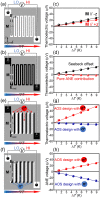Magneto-optical design of anomalous Nernst thermopile
- PMID: 34045651
- PMCID: PMC8160345
- DOI: 10.1038/s41598-021-90865-5
Magneto-optical design of anomalous Nernst thermopile
Abstract
The introduction of spin caloritronics into thermoelectric conversion has paved a new path for versatile energy harvesting and heat sensing technologies. In particular, thermoelectric generation based on the anomalous Nernst effect (ANE) is an appealing approach as it shows considerable potential to realize efficient, large-area, and flexible use of heat energy. To make ANE applications viable, not only the improvement of thermoelectric performance but also the simplification of device structures is essential. Here, we demonstrate the construction of an anomalous Nernst thermopile with a substantially enhanced thermoelectric output and simple structure comprising a single ferromagnetic material. These improvements are achieved by combining the ANE with the magneto-optical recording technique called all-optical helicity-dependent switching of magnetization. Our thermopile consists only of Co/Pt multilayer wires arranged in a zigzag configuration, which simplifies microfabrication processes. When the out-of-plane magnetization of the neighboring wires is reversed alternately by local illumination with circularly polarized light, the ANE-induced voltage in the thermopile shows an order of magnitude enhancement, confirming the concept of a magneto-optically designed anomalous Nernst thermopile. The sign of the enhanced ANE-induced voltage can be controlled reversibly by changing the light polarization. The engineering concept demonstrated here promotes effective utilization of the characteristics of the ANE and will contribute to realizing its thermoelectric applications.
Conflict of interest statement
The authors declare no competing interests.
Figures




References
-
- Goldsmid HJ. Introduction to Thermoelectricity. Springer; 2009.
-
- Champier D. Thermoelectric generators: a review of applications. Energy Convers. Manage. 2017;140:167–181. doi: 10.1016/j.enconman.2017.02.070. - DOI
-
- He R, Schierning G, Nielsch K. Thermoelectric devices: A review of devices, architectures, and contact optimization. Adv. Mater. Technol. 2018;3:1700256. doi: 10.1002/admt.201700256. - DOI
-
- Haras M, Skotnicki T. Thermoelectricity for IoT—A review. Nano Energy. 2018;54:461–476. doi: 10.1016/j.nanoen.2018.10.013. - DOI
Grants and funding
LinkOut - more resources
Full Text Sources
Other Literature Sources

